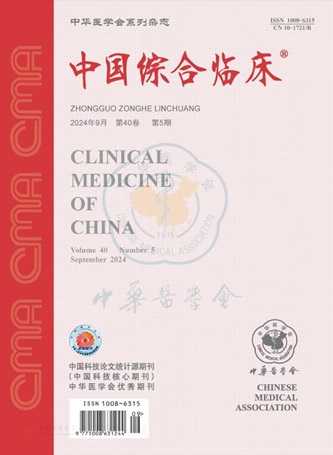Protective effect of laparoscopic removal of water and suture hemostasis on ovarian function
引用次数: 0
Abstract
Objective To investigate the protective effect of laparoscopic water separation and removal combined with suture hemostasis on ovarian reserve function after bilateral ovarian endometriotic cyst (OEC) stripping. Methods From January 2016 to January 2018, 60 patients with bilateral ovarian endometriosis cystectomy underwent laparoscopic surgery in the Department of Obstetrics and Gynecology, Jiading Hospital of traditional Chinese medicine.According to the random number table method, they were divided into study group (water separation and stripping combined suture hemostasis group) and the control group (direct stripping combined with electrocoagulation hemostasis group), 30 cases in each group.The changes of operation time, hemoglobin level before and after operation and the levels of follicle stimulating hormone (FSH), luteinizing hormone (LH), estradiol (E2) and anti Mullerian hormone (AMH) were compared between the two groups. Results There was no significant difference in operation time (47.52 ±10.11) min, hemoglobin decrease (0.55 ±0.26) g/L, hospital stay (6.1 ±0.3) d, control group (48.01 ±10.24) min, hemoglobin decrease (0.56 ±0.25) g/L and hospitalization time (6.2 ±0.4) d before and after operation (t=0.056, 0.964, 0.863, all P>0.05). The levels of FSH, E2, LH and AMH in the study group before operation were (6.15 ±2.31) U/L, (152.41 ±41.40) nmol/L, (5.44 ±1.52) U/L and (2.21 ±0.13) μg/L, respectively.One month after operation, they were(6.21±2.24) U/L, (150.63±40.33) nmol/L, (5.13±1.58) U/L, (2.18±0.16) μg/L, respectively.Three months after operation, they were (6.52±2.41) U/L, (149.57±42.37) nmol/L, (5.30±1.45) U/L, (2.17± 0.15) μg/L, respectively.Six months after operation, they were (6.53±2.44) U/L, (151.36±41.54) nmol/L, (4.98±1.61) U/L, (2.20±0.08) μg/L, respectively.The levels of FSH, E2, LH and AMH in the control group before operation were (6.14±2.21) U/L, (153.31±40.39) nmol/L, (5.51±1.46) U/L, (2.23±0.13) μg/L, respectively.One month after operation, they were (8.11±2.44) U/L, (131.43±41.23) nmol/L, (5.92±1.64) U/L, (1.58±0.14) μg/L, respectively.Three months after operation, they were (8.42±2.35) U/L, (135.67±40.38) nmol/L, (6.12±1.51) U/L, (1.54±0.16) μg/L, respectively.Six months after operation, they were (9.17±2.64) U/L, (133.66±40.44) nmol/L, (6.28±1.74) U/L, (1.51±0.13) μg/L, respectively.There was no significant difference in the levels of FSH, E2, LH and AMH between the two groups (all P>0.05). There was significant difference between the preoperative FSH level and the postoperative 1, 3, 6 months in the control group (all P<0.05); there was significant difference between the preoperative E2 level and the postoperative 1 month in the control group (P<0.05); there was statistical significance between the preoperative AMH level and the postoperative 1, 3 months in the control group (all P<0.05). The levels of FSH, LH, E2 and AMH in the study group were significantly higher than those in the control group (all P<0.05). Conclusion Laparoscopic hydrodissection combined with suture hemostasis does not increase the operation time and the amount of bleeding, and does not affect the ovarian reserve function after operation. Key words: Ovarian endometrioma; Hydrodissection; Suture hemostasis; Ovarian reserve function腹腔镜下放水缝合止血对卵巢功能的保护作用
目的探讨腹腔镜下分离出水联合缝合止血对双侧卵巢子宫内膜异位性囊肿(OEC)剥除后卵巢储备功能的保护作用。方法2016年1月至2018年1月,在嘉定中医院妇产科行腹腔镜下双侧卵巢子宫内膜异位症膀胱切除术患者60例。按随机数字表法将患者分为研究组(水分离剥脱联合缝合止血组)和对照组(直接剥脱联合电凝止血组),每组30例。比较两组患者手术时间、手术前后血红蛋白水平及促卵泡激素(FSH)、黄体生成素(LH)、雌二醇(E2)、抗苗勒管激素(AMH)水平的变化。结果两组手术时间(47.52±10.11)min,血红蛋白下降(0.55±0.26)g/L,住院时间(6.1±0.3)d,对照组(48.01±10.24)min,血红蛋白下降(0.56±0.25)g/L,住院时间(6.2±0.4)d,术前、术后差异无统计学意义(t=0.056、0.964、0.863,P均为0.05)。研究组术前FSH、E2、LH、AMH水平分别为(6.15±2.31)U/L、(152.41±41.40)nmol/L、(5.44±1.52)U/L、(2.21±0.13)μg/L。术后1个月分别为(6.21±2.24)U/L、(150.63±40.33)nmol/L、(5.13±1.58)U/L、(2.18±0.16)μg/L。术后3个月分别为(6.52±2.41)U/L、(149.57±42.37)nmol/L、(5.30±1.45)U/L、(2.17±0.15)μg/L。术后6个月分别为(6.53±2.44)U/L、(151.36±41.54)nmol/L、(4.98±1.61)U/L、(2.20±0.08)μg/L。对照组术前FSH、E2、LH、AMH水平分别为(6.14±2.21)U/L、(153.31±40.39)nmol/L、(5.51±1.46)U/L、(2.23±0.13)μg/L。术后1个月分别为(8.11±2.44)U/L、(131.43±41.23)nmol/L、(5.92±1.64)U/L、(1.58±0.14)μg/L。术后3个月分别为(8.42±2.35)U/L、(135.67±40.38)nmol/L、(6.12±1.51)U/L、(1.54±0.16)μg/L。术后6个月分别为(9.17±2.64)U/L、(133.66±40.44)nmol/L、(6.28±1.74)U/L、(1.51±0.13)μg/L。两组患者FSH、E2、LH、AMH水平比较,差异均无统计学意义(P < 0.05)。对照组术前FSH水平与术后1、3、6个月比较,差异均有统计学意义(P<0.05);对照组术前E2水平与术后1个月比较,差异有统计学意义(P<0.05);对照组患者术前AMH水平与术后1、3个月比较,差异均有统计学意义(P<0.05)。研究组FSH、LH、E2、AMH水平均显著高于对照组(均P<0.05)。结论腹腔镜下水解剖联合缝合止血不增加手术时间和出血量,不影响术后卵巢储备功能。关键词:卵巢子宫内膜异位瘤;;囊袋上缝合止血;卵巢储备功能
本文章由计算机程序翻译,如有差异,请以英文原文为准。
求助全文
约1分钟内获得全文
求助全文
来源期刊
CiteScore
0.10
自引率
0.00%
发文量
16855
期刊介绍:
Clinical Medicine of China is an academic journal organized by the Chinese Medical Association (CMA), which mainly publishes original research papers, reviews and commentaries in the field.
Clinical Medicine of China is a source journal of Peking University (2000 and 2004 editions), a core journal of Chinese science and technology, an academic journal of RCCSE China Core (Extended Edition), and has been published in Chemical Abstracts of the United States (CA), Abstracts Journal of Russia (AJ), Chinese Core Journals (Selection) Database, Chinese Science and Technology Materials Directory, Wanfang Database, China Academic Journal Database, JST Japan Science and Technology Agency Database (Japanese) (2018) and other databases.

 求助内容:
求助内容: 应助结果提醒方式:
应助结果提醒方式:


